Cleveland, Ohio's Sidaway Bridge: A Bridge Over Troubled History
Site of a horrendous serial killing spree, a 1960's race riot and now a reminder of what once was...
An abandoned landmark bridge in Cleveland, Ohio. A horrific string of murders committed by a serial killer, who used the area around the bridge as their own personal dumping zone. A famous Prohibition-era investigator flummoxed and justice for heinous crimes never realized. Horrid and inhuman crimes that remain unsolved to this very day. All of that and more in the upcoming Rust Belt tale!
If you find yourself in Cleveland and drive down the new Opportunity Corridor between East 55th and Kinsman, you’ll find yourself cruising over a bridge that crosses a rather large and vegetation-choked ravine called the Kingsbury Run, and if you’re able to look to the south as you cross (if the Dukes of Hazzard-ish driving behaviors of the local Clevelanders doesn’t distract the hell out of you first), you’ll spot it. A sinuous and still proud suspension bridge, brown and red with rust, spanning over the lush and garbage strewn Run below, encrusted with encroaching vines and greenery over a third of its length. You’re looking at The Sidaway Bridge, Cleveland’s ONLY suspension bridge and a relatively hidden abandoned photographic gem of one that’s been abandoned since the 1960’s. Hoisted high above the trickling water and broken rubble below by two 158-tall steel towers, the thin walkway, measuring 680 feet, once connected two neighborhoods in a much different time; nowadays, the wooden slats that once allowed a pedestrian to cross from Slavic Village at Sidaway Avenue in the west to Kinsman at East 65th on the east are mostly gone, leaving massive empty gaps where only the ballsiest climbers will attempt to climb in this modern age. Blown out Bakelite light hoods sans bulbs can still be seen where the bridge runs through its towers. The mega-thick woven steel cables are caked with rust but still appear trustworthy to hold the weight of what’s left of the wrecked span, but as far as crossing it…that takes a shit-ton of effort and a brass set of cajones to even attempt. I know a few who have, but yours truly is content to shoot the amazing bridge from below. Looking back on historical photos of the Sidaway Bridge, it was a stunning and beautiful sight a little less than a century ago, and though it looks like something out of the latest Fallout offering now, it still has that breathtaking mojo going on as you witness it standing tall even despite all of the history its seen.
One can shoot the bridge from either side, though to be honest, the western end is a hell of a lot harder to get a clean shot of due to all the vegetation. Even despite someone going apeshit with a weed-wacker on all of the jungle-like overgrowth between Sidaway Avenue and your view of the bridge, its still hard to do with all of the trees in the way. Even in the winter. Head over to the other side, and someone (or likely generations of someones) had the kind forethought to create a little path through the trees, weeds and vines to a little ledge on the side of the ravine, where you can get a pretty decent shot of the graceful old dame. Even better when there’s snow on the ground to contrast the red and dark brown rust of the cables and steel of the ravaged walkway. I know I’ll be heading back as soon as we get some snow to get that image in my camera’s crosshairs.
A little history on the Sidaway Bridge (and as it turns out, quite detailed history). There WAS a bridge before it rose to prominence above the Kingsbury Run, though it was nothing to write home about. The first bridge in this location was built in 1909 under the regime of Mayor Tom L. Johnson; a rickety wooden, trestle bridge known as the Tod-Kinsman Bridge. Functional, sure. Good looking? Eh. But it got the job done. It successfully connected the two adjacent neighborhoods on either side of the Run, but eventually, it ran into a singular problem that needed correcting. The bland wooden structure became an obstacle for the Nickel Plate Railroad traveling below, and as railroad was KING in the early part of the 20th Century, that wasn’t going to fly. So, with some easy funding from the railroad, now owned by Cleveland’s own tycoon duo, the Van Sweringen brothers, a new bridge was planned in 1929. Designed by architect Fred L. Plummer, working for Wilbur Watson & Associates, the bridge we now know today as the Sidaway Bridge opened in 1930.
Sidaway Bridge in the 1930’s-1950’s (Cleveland Historical)
Now for the bridge’s part in a much larger story. A rather grisly story. The Sidaway Bridge was a thing of beauty, but it had the unexpected disadvantage of having been built at a rough time in American history. The US had just been tossed head first into the Great Depression, and the Kinsbury Run area became a shanty town for displaced, homeless and out-of-work people, all victims of the Stock Market crash of 1929. So, anyone crossing the bridge to get from one neighborhood to the other was bound to see some pretty unsavory things going on down below. Crime was rampant all over Cleveland, but the Run was one of those out of the way places where bad juju dark vibes and the worst of human impulses could marinate, ripen and burst open like an infected wound. Prostitution, theft and all out brawls were typical occurrences all over the area, and the local cops had so much to cover that the Run wasn’t usually a priority. The Run was also known as "The Roaring Third" or "Hobo Jungle", known for its nearby bars, gambling dens, brothels and vagrants. Bad enough and tough all over…until it got worse, and that’s where the real story about our wonderful Sidaway Bridge and its neighborhood starts to take off and morph into a thick, dark glob of pure foulness.
Kingsbury Run, 1930’s (Cleveland Historical)
Amidst all of the many mundane horrors that Clevelanders experienced in the Depression, starting in 1934, bodies began appearing in Kingsbury Run. Dismembered bodies. Heads removed. Arms and legs removed. Evisceration. Sometimes, the only evidence left behind was the torso of some unlucky beggar, hooker or down-on-their-luck railroad worker. Later, this modus operandi would spread to other locations around Cleveland, most often around the rail lines, but it all started in the Kingsbury Run, in the shadow (sometimes quite literally) of the Sidaway Bridge. Cleveland had itself a genuine serial killer, in a time when real investigative units formed to handle such horrors were not even a twinkle in the future. Local cops were flummoxed, and sadly, to most citizens outside the Run, the victims were just bums, rail hobos and worn out harlots, so who really cared? The serial killer responsible would become known nationwide as the Cleveland Torso Murderer. As we’ll see, the killer was never caught, and the whole case brought increased notoriety to the area.
The unknown murderer was also known as the Mad Butcher of Kingsbury Run, whose horrific and visceral killings were characterized by the dismemberment of twelve known victims, almost all from the shantytowns built within the Run and the disposal of their remains in the impoverished neighborhood of the surrounding area. The Torso Murderer always beheaded and often dismembered their victims, occasionally severing the victim's torso in half or severing their appendages (hence the nickname) In many cases the cause of death was the decapitation or dismemberment itself. Most of the male victims were castrated. Some victims showed evidence of chemical treatment being applied to their bodies, which caused the skin to become red, tough and leathery. Many were found after a considerable period of time following their deaths, occasionally in excess of a year. Again, this was an era when forensic science was largely in its infancy, so any kind of logical investigation as we’d know it today wasn’t in the offing. DNA testing and other post-mortem techniques didn’t exist, so the passing of time further complicated identification, especially since the heads were often undiscovered.
Detectives of the Cleveland Police Department under the Sidaway Bridge (1930’s)(Cleveland Historical)
The twelve known victims were killed between 1935 and 1938, though investigations over the years show that there might have been many more, not just in Cleveland, but in other cities along the same rail lines, leaning to the idea that the murderer might have been a railroad worker who would kill, then skip town for awhile as his train left, murder abroad, then return later to continue the spree in Cleveland. Pittsburgh and New Castle, Pennsylvania also reported similar killings at the same time. Several other bodies were found that were tentatively tied to the serial killer’s spree, though not enough evidence exists to do so conclusively. Two strong candidates for addition to the "official" list is the unknown victim nicknamed the "Lady of the Lake," found on September 5, 1934, floating in the oil-sludgy industrial flotsam and muck soaked shores of Cleveland’s harbor on Lake Erie near downtown and Robert Robertson, found much later than all the others, in the East side Cleveland area on July 22, 1950. As mentioned, most of the victims of the Torso Murderer were usually drifters whose identities were never determined, although there were a few exceptions. Victims numbers 2, 3 and 8 were identified as Edward Andrassy, Florence Polillo and possibly Rose Wallace, respectively. Andrassy and Polillo were both identified by their fingerprints, while Wallace was tentatively identified via her dental records. The victims appeared to be lower class individuals–easy prey during the Great Depression. Many were known as "working poor", who had nowhere else to live but the ramshackle shanty towns, or "Hoovervilles", in the area known as the Cleveland Flats and near Kingsbury Run along the rail lines.
Kingsbury Run, 1930’s (Cleveland, Ohio) (Cleveland Historical)
During the time of the "official" murders, Eliot Ness, leader of the famous Untouchables, (special agents of the U.S. Bureau of Prohibition from 1930 to 1932, who worked to end Al Capone's illegal activities by aggressively enforcing Prohibition laws against his organization). was serving as Cleveland's Public Safety Director, a position with authority over the police department and civic services, including the fire department. Ness contributed to the arrest and interrogation of one of the prime suspects, Dr. Francis Sweeney, and personally conducted raids into shantytowns and eventually burned them down. Ness's reasoning for torching the shacks of the downtrodden was to catalog fingerprints to easily identify any new victims, and to get possible victims out of the area in an attempt to stop the murders…not that it did any good.
“Untouchable” Eliot Ness (Hulton Archive/Getty Images)
Four days after the burning, on August 22, 1938, Ness launched an utterly draconian operation where he personally dispatched six two-man search teams on a large area of Cleveland, stretching from the Cuyahoga River to East 55th Street to Prospect Avenue, under the guise of conducting city fire inspections. While the search never turned up any new or incriminating information that could lead to the arrest and conviction of the Torso Murderer, it did serve to focus renewed public attention on the inadequate and unsanitary living conditions in the downtown area in that era. We’re talking Third World Country level at best. Teams uncovered hundreds of families living in hazardous fire-ready death traps without toilets or running water. Tar paper tenements. The interests of social reform did ultimately come to light even if those of law enforcement did not, so at least SOMETHING came out of the failure to find the killer.
As the ordeal of fear lingered on in the Cleveland area, at one point in time, the Torso Murderer went all out and taunted Ness by placing the remains of two victims in full view of his office in City Hall. The man who Ness believed to be the killer would later also provoke him by sending postcards. The postcards written by the perp insisted that he had moved to California,had killed a woman there and had buried the head in Los Angeles. In the letter, the killer referred to himself as a "DC" or Doctor of Chiropractic. An investigation uncovered animal bones. Ness had to have been royally pissed and frustrated by the inability to take down the Torso Murderer, and after years of trying and after the murders ceasing in the Cleveland area, the investigation closed. It was never discovered who the murderer was and the mystery lingers under the Sidaway Bridge to this day. A stone-frozen cold case in 2023. Elliot Ness DID attempt, unsuccessfully, to run for Cleveland mayor in the 1940’s, after his time investigating and later left the city by the lake for greener pastures. What could have been had he only been able to ferret out the mass murdering fiend that had terrified Cleveland for years.
A Mayor never to be…
There are numerous books and documentaries about the Torso Murders out there, but there’s one to go-to if you want all the gory details, in my humble opinion. The best book to check out is by far “In the Wake of the Butcher: Cleveland’s Torso Murders” by James Jessen Badal. Fairly cheap and easy to find on Amazon. Worth the read.
But as for the Sidaway Bridge, that was just a footnote in its long history. The now-abandoned bridge still had a major part to play in Cleveland history, and the grand finale wouldn’t come until thirty some years after the Torso Murders went down. Enter 1966. The United States was in the middle of long, hot summer, and at that time, the Civil Rights movement was slowly simmering in almost every corner of the country. By July, the gasoline had been spread via anger, frustration, racism and years of abuse, and on July 18th, 1966, the match was finally struck. In the Hough neighborhood of Cleveland, several miles from the Sidaway Bridge, one of the most infamous race riots was about to kick off in violent and vicious fashion. African-Americans had moved into the neighborhoods around the Sidaway over the last decade or so, and the racial tensions between the white stay-behinds and their new neighbors of color had reached a boil-over. And justly so. Substandard and overcrowded housing, overcharging for necessities by area merchants, and ever-increasing incidents of police harassment. The flames finally caught (literally) and the riots erupted when the white bar owner of the Seventy-Niners Cafe at Hough Avenue and E. 79th St. denied a Black takeout customer a glass of water on the evening of July 18th. Police were increasingly unable to deal with the growing angry crowd, as rock throwing escalated into vandalism and looting which spread throughout the surrounding neighborhood. The following evening the disorder continued, with fires set in the area as well as reports of sniper fire. The National Guard moved into Hough on the morning of July 20th to restore order, and the mayor closed all bars and taverns. After a major fire at Cedar and E. 106th on the 21st, things slowly returned to normal, or whatever stood for normal. On Monday, July 25th, those stores in the Hough area that had escaped serious damage reopened, and the National Guard was gradually released from duty. During the riots, four people were killed, all of them African American. Two were innocent bystanders apparently caught in the crossfire, and the other two were killed outside of the neighborhood. About 30 were injured, including a family of four shot when their car failed to stop at a police barricade; close to 300 were arrested, and approx. 240 fires were set, resulting in an estimated $1-2 million in property damage.
Protests leading up to the Hough Riots in Cleveland (Zinn Education Project)
What does all of this have to do with the Sidaway Bridge? Well, even though the riots took place 2 miles north of the bridge, the violence and rage spilled out into the surrounding area. Vandalism and confrontation was definitely a thing and the riots did leak out into surrounding neighborhoods. Some unknown asshole set fire to the wooden plank walkway of the bridge, rendering it uncrossable. No one was ever charged with the crime, but rumors were flying about the area and the act was widely interpreted as a racially motivated effort to separate the majority white neighborhood of Slavic Village from the majority black Kinsman neighborhood. No proof or solid evidence for it, but considering the tensions of that time, it wouldn’t be surprising.
“Bridge Closed” (Cleveland Historical)
Following the vandalism in 1966, the city of Cleveland removed most of what was left of the wooden planking from the bridge and closed it to the public. It has remained closed and abandoned since, Mother Nature slowly slithering her green tendrils over the rusting steel cables and the brutal Cleveland lake-effect winters spreading that rust out in wider patches, year by year. In the 1976 case Reed v. Rhodes, Judge Frank J. Battisti said in a court memorandum and order that the city of Cleveland and the school district had chosen not to repair the bridge in order to continue the neighborhood segregation and prevent black students from easily walking to the white schools on the other side of the bridge. Again, that was never proven 100%, but would you REALLY be surprised?
A sad span…
So, there you have it. The Sidaway Bridge has seen some seriously heavy history. Exploring the area around the Kingsbury Run definitely provides that feeling. It's an eerie, unnaturally quiet and restless place and I have no doubt that a good deal of roiling and negative remembrances that came from violent murders and the abrupt and visceral end of life, the hopelessness of the unwashed poverty that oozed through its forlorn reaches and the negative vibes that came from years of racial hatred coalesce into one murky and dense flow of residual energy that sits heavily over the bridge and its surroundings. The whole place just feels dim, if that makes any sense. It feels lonely. It feels tired and sad. It feels like a rough edged shard of metal that has broken off from a much bigger machine. Maybe that’s me being melodramatic and maybe it's just the sight of this old rusting steel suspension bridge looking like something out of Planet of the Apes. Down below the brooding span, all that exists are the gravel access roads that lead to the Cleveland Rapid Transit Authority’s old train test tracks, which as far as I know are no longer in use, old rusting cargo containers, overgrown weeds, unruly vegetation and windblown trash. Down there is where decapitated bodies were all found, dumped in an inhuman act like sacks of garbage, lost souls who never had any chance to fight back against an unseen murderer who took their lives so viciously, down there under the shadow of the bridge. Truly one of the saddest places in town if you venture down the hill to the bottom. It's not a place that welcomes you in, even on a sunny summer day with blue skies. Whatever it is that covers the acreage like a shroud, the place is just…off.
According to what I’ve heard over the last few years, rumors have been swirling about a possible restoration of the bridge to its former glory. In early October 2022, the Sidaway Bridge was added to the National Register of Historic Places in acknowledgement of its role in the Civil Rights Movement. The new historic designation, it is hoped, might advance efforts to restore the bridge, establish a park, and set the stage for possible future development in the surrounding area. The bridge is owned by the city of Cleveland at current, and who knows how far things will get on that end, knowing city government as we all do, BUT, it is possible that maybe an entity with some experience in restoring wrecked up landmarks and property might step in and get the job done. I’m talking about the Cleveland Metroparks. A Kingsbury Run Reservation sounds pretty damn good. And it would be amazing to see the Sidaway Bridge cleaned up and restored to its original look and crossability. Even more amazing to be able to walk out onto it without fear of falling to one’s death while attempting to get shots out on its floorless span. Time will tell. For now, it stands as an amazing place to get that apocalyptic shot of a bridge to nowhere in a place that has seen some seriously heavy and rather horrific history.
(All photos taken by author unless otherwise noted)
If you enjoyed the story and the history, consider sharing it to your feed and maybe even think about subscribing for weekly content (stories, photos and more!) Thanks for reading and have a great day out there! -Mr. P.

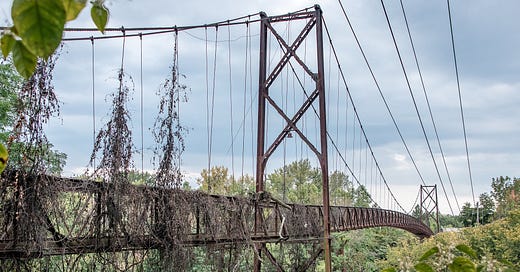



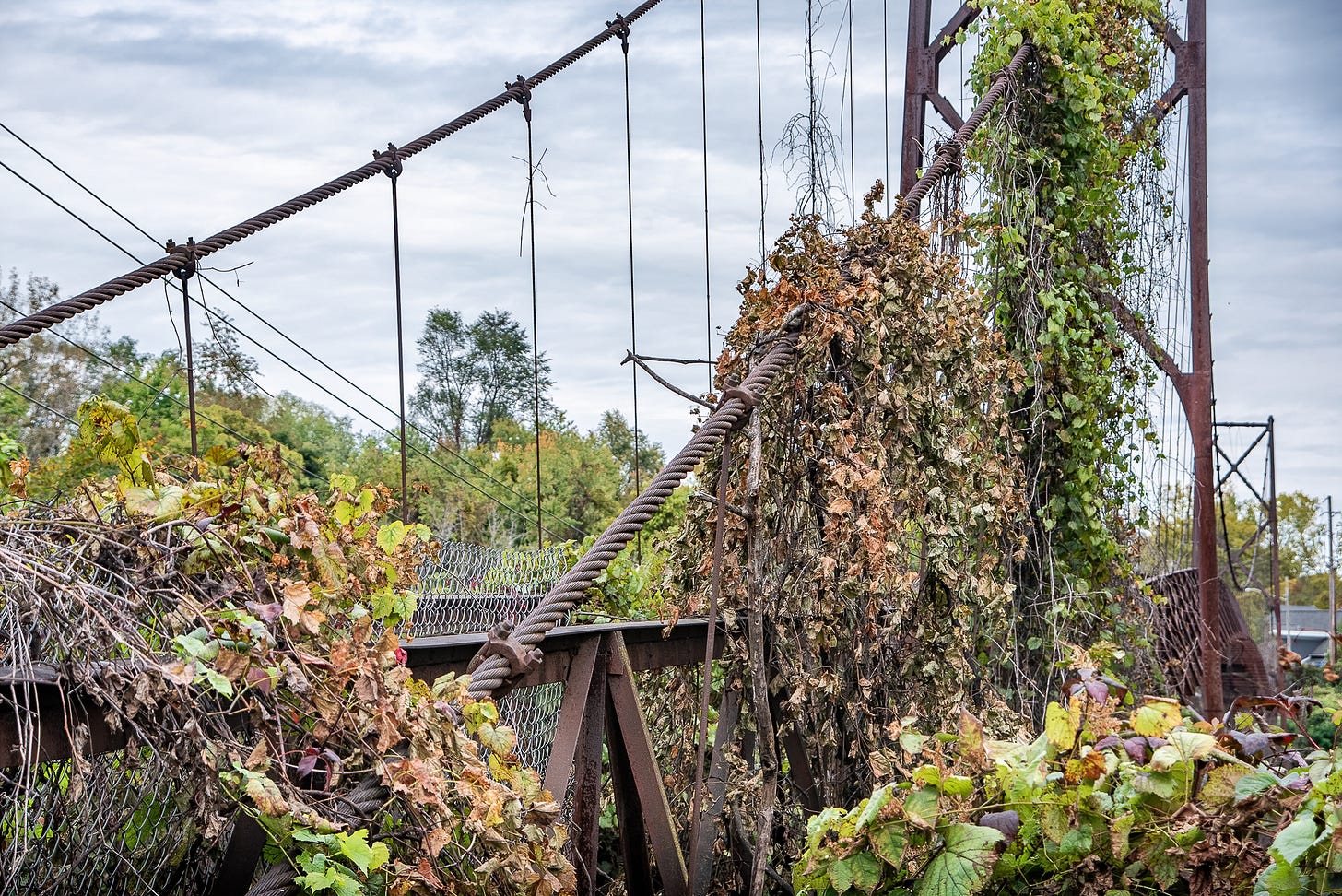
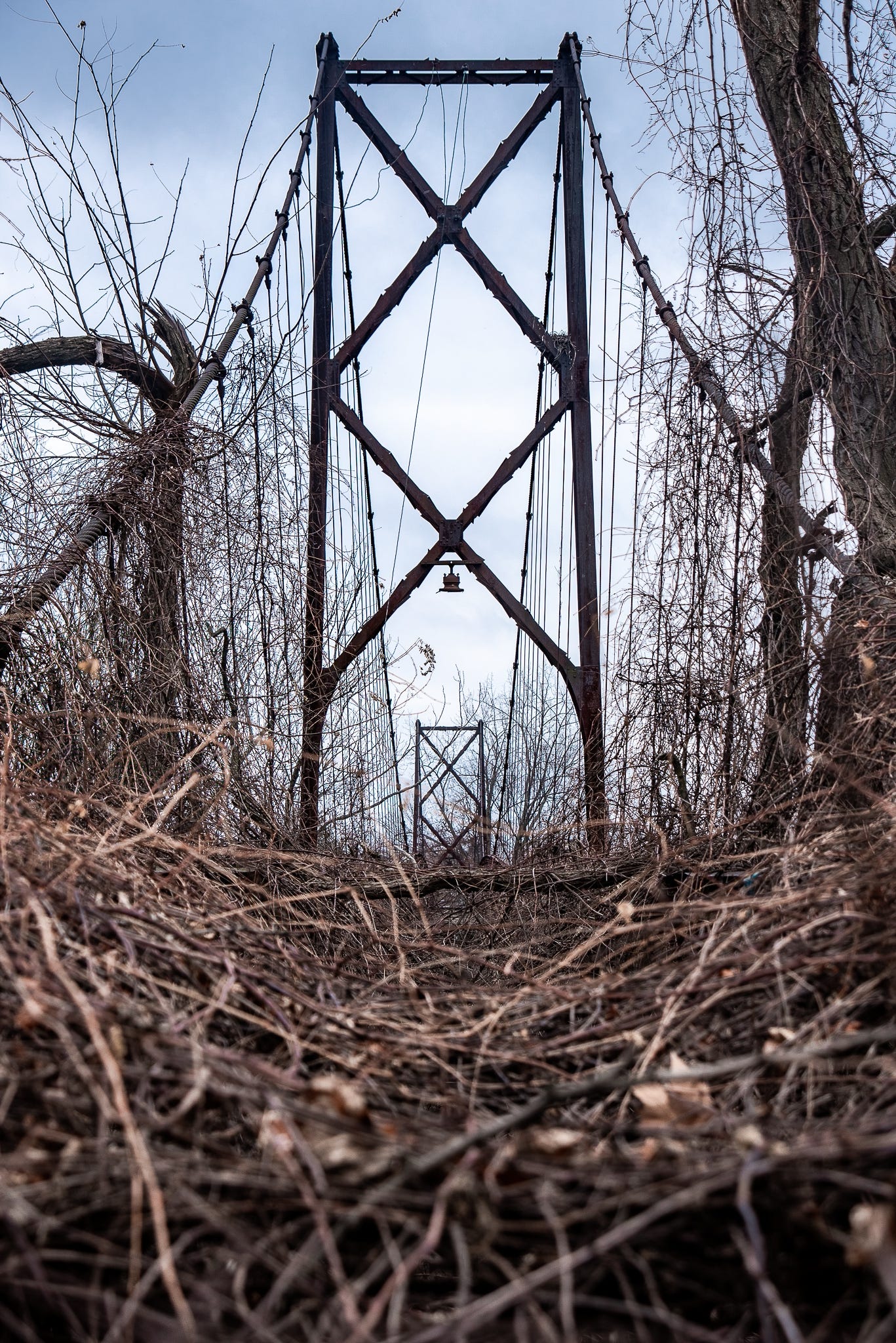
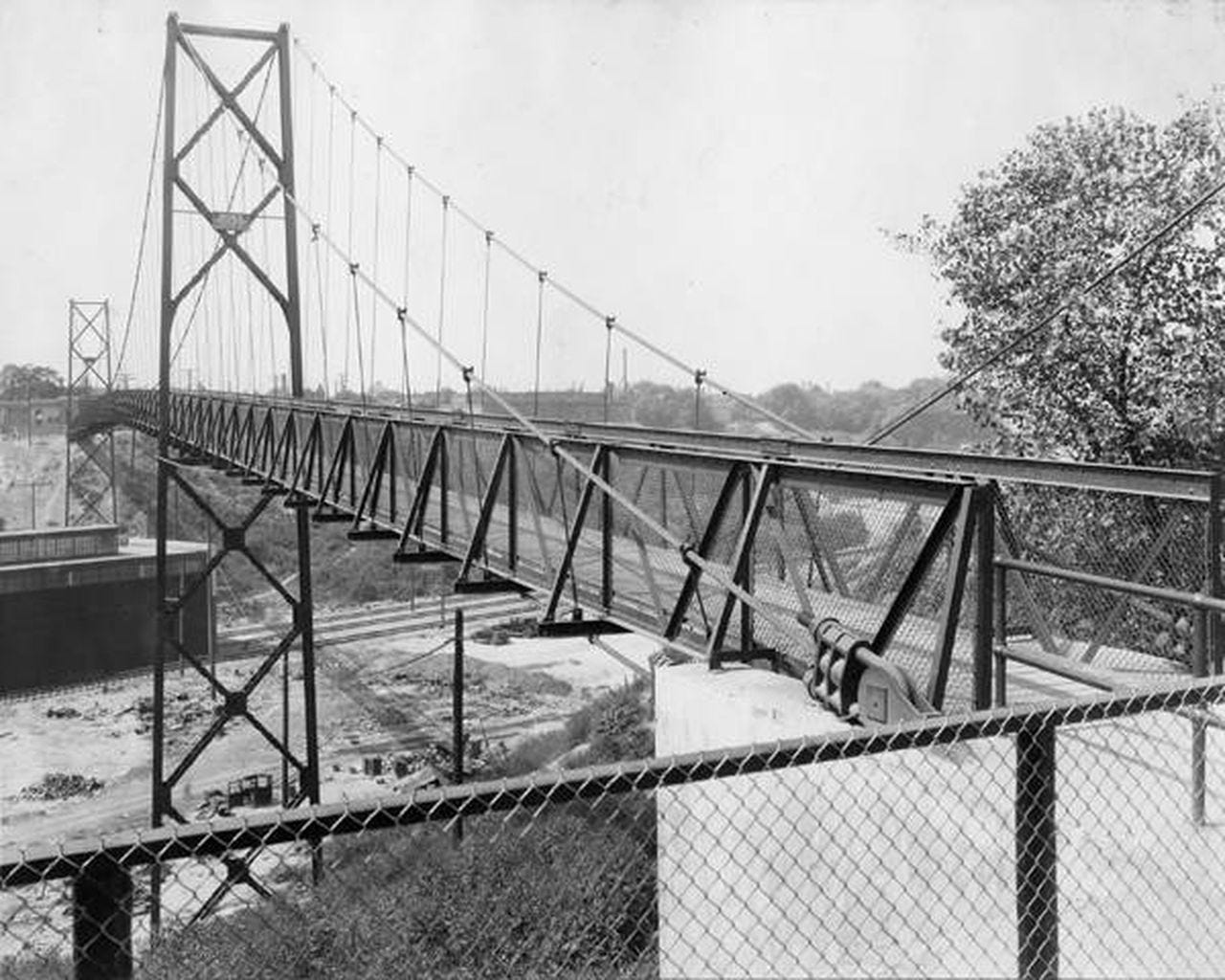
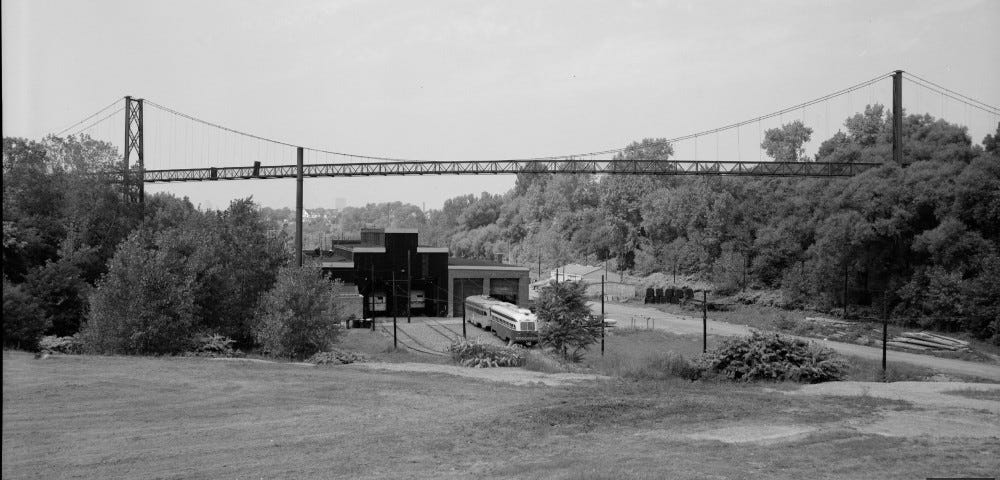
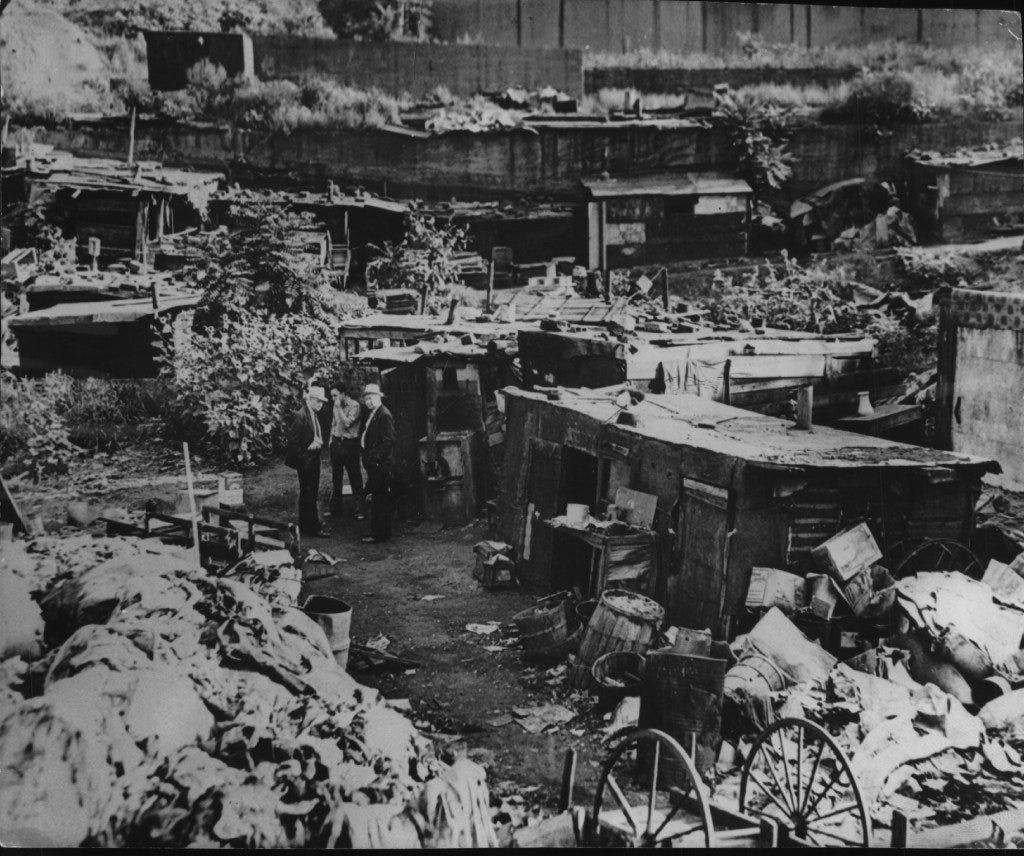
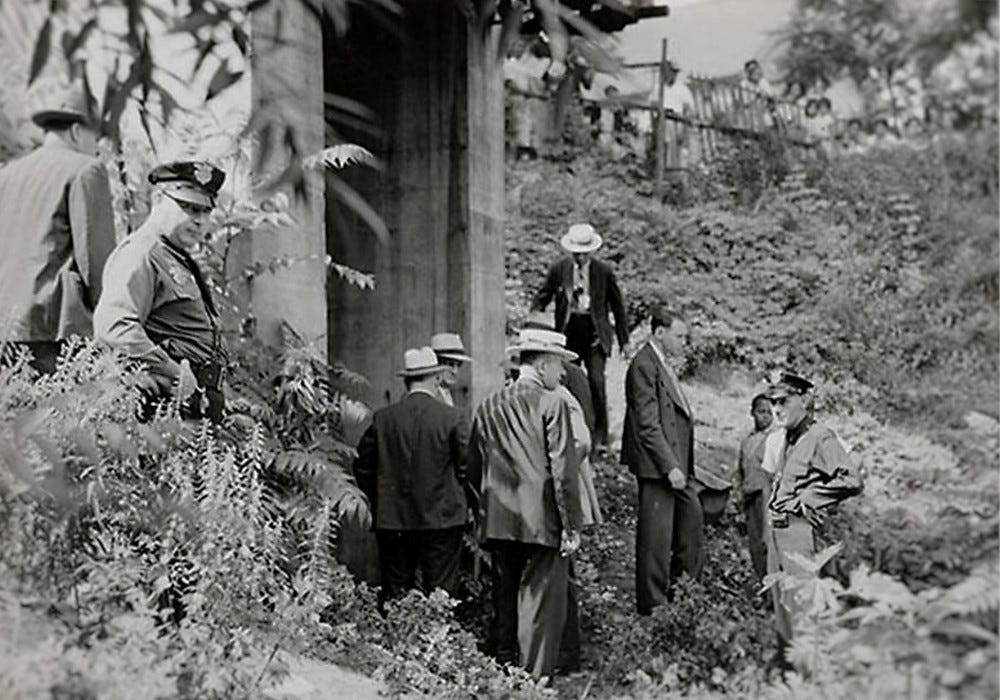
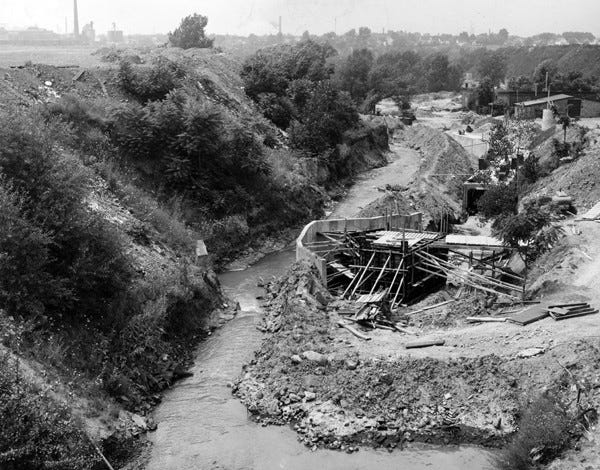

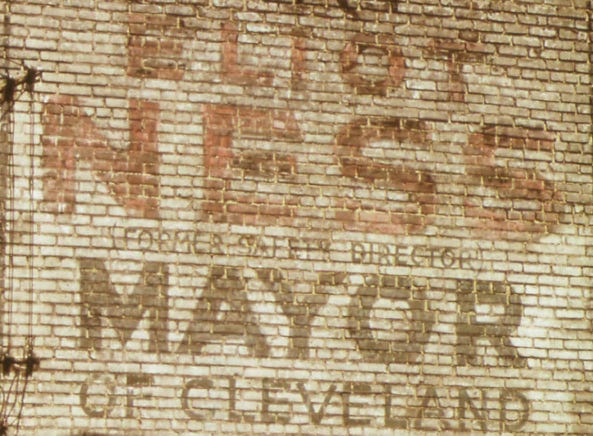
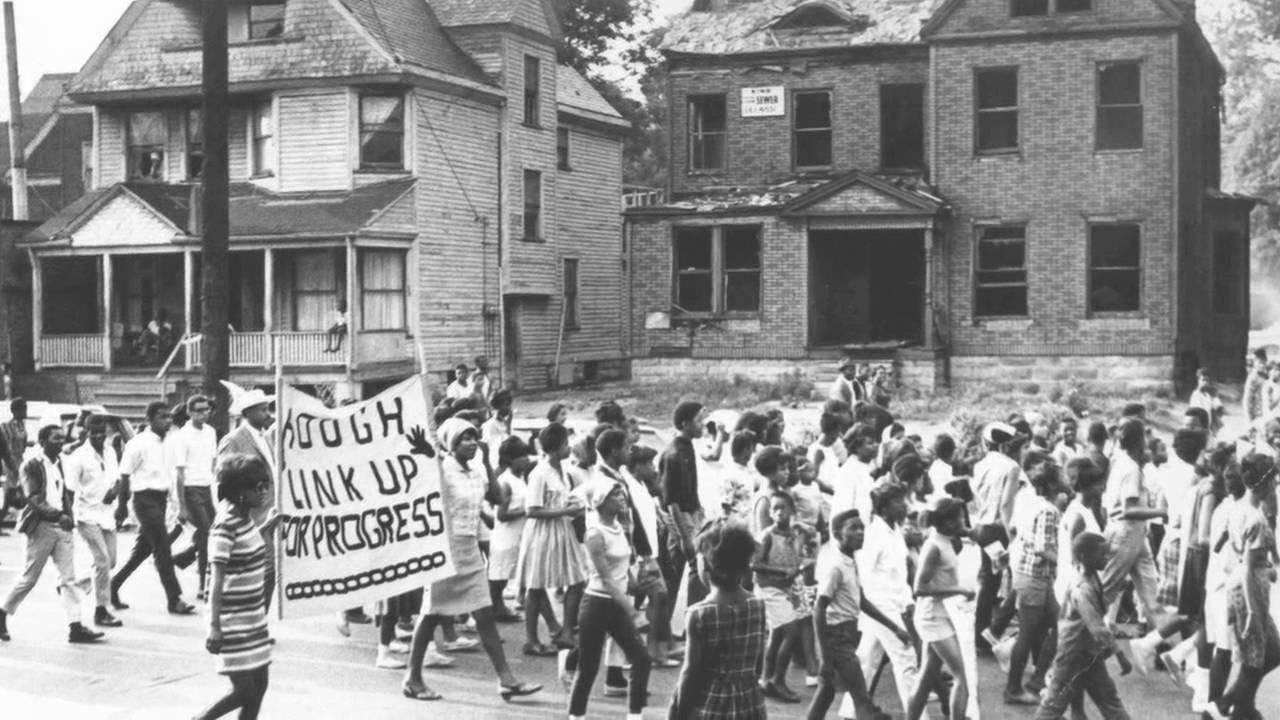
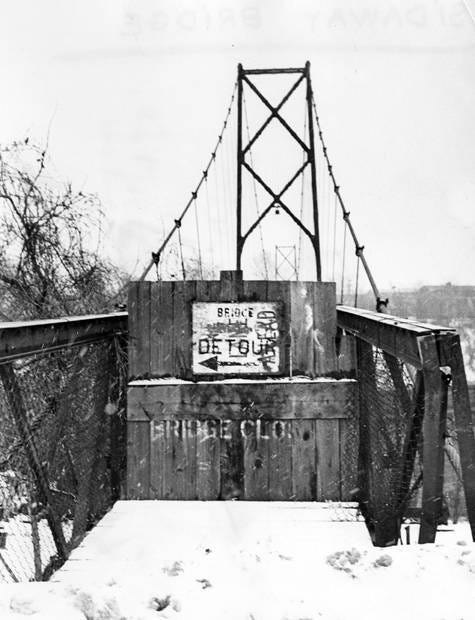

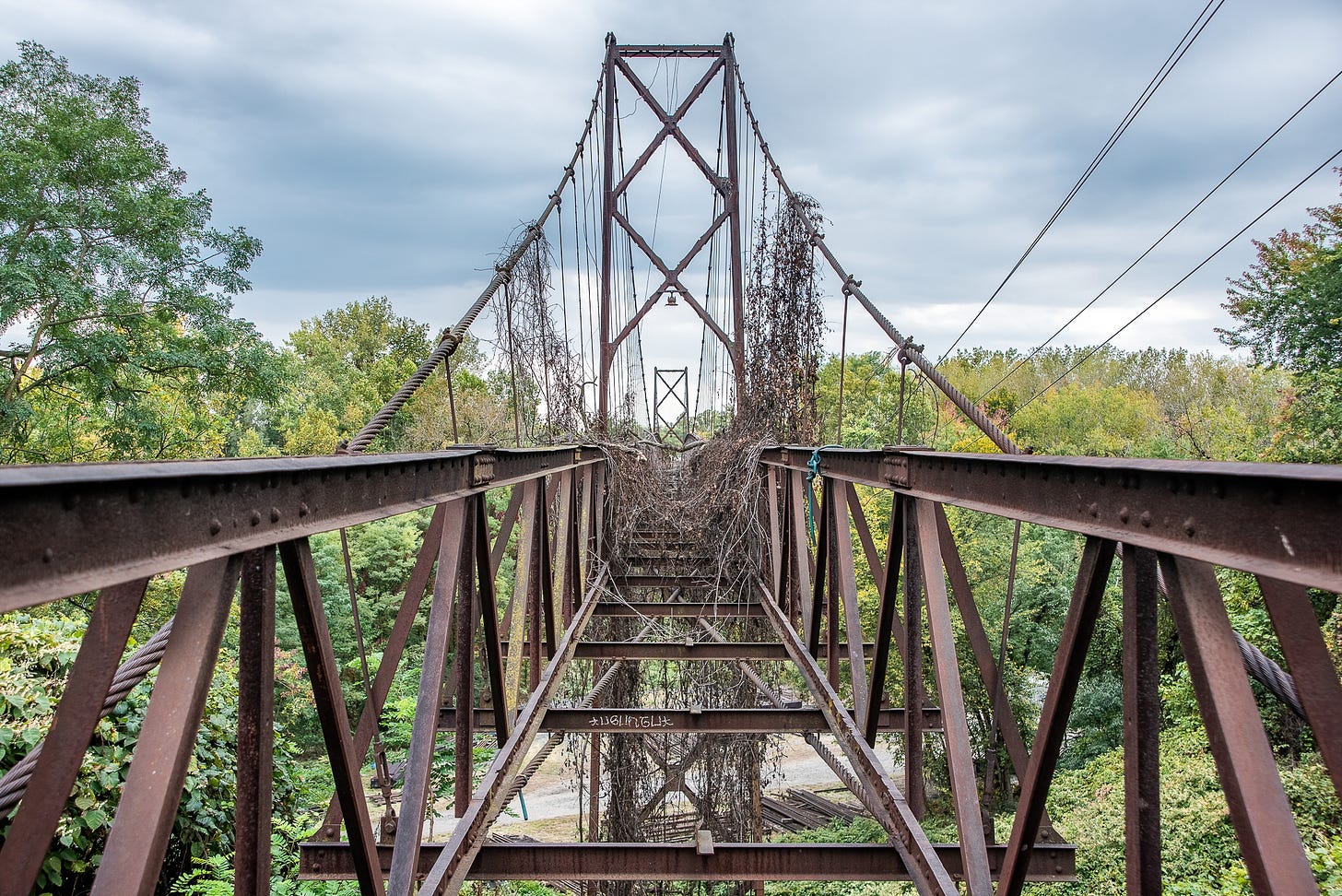
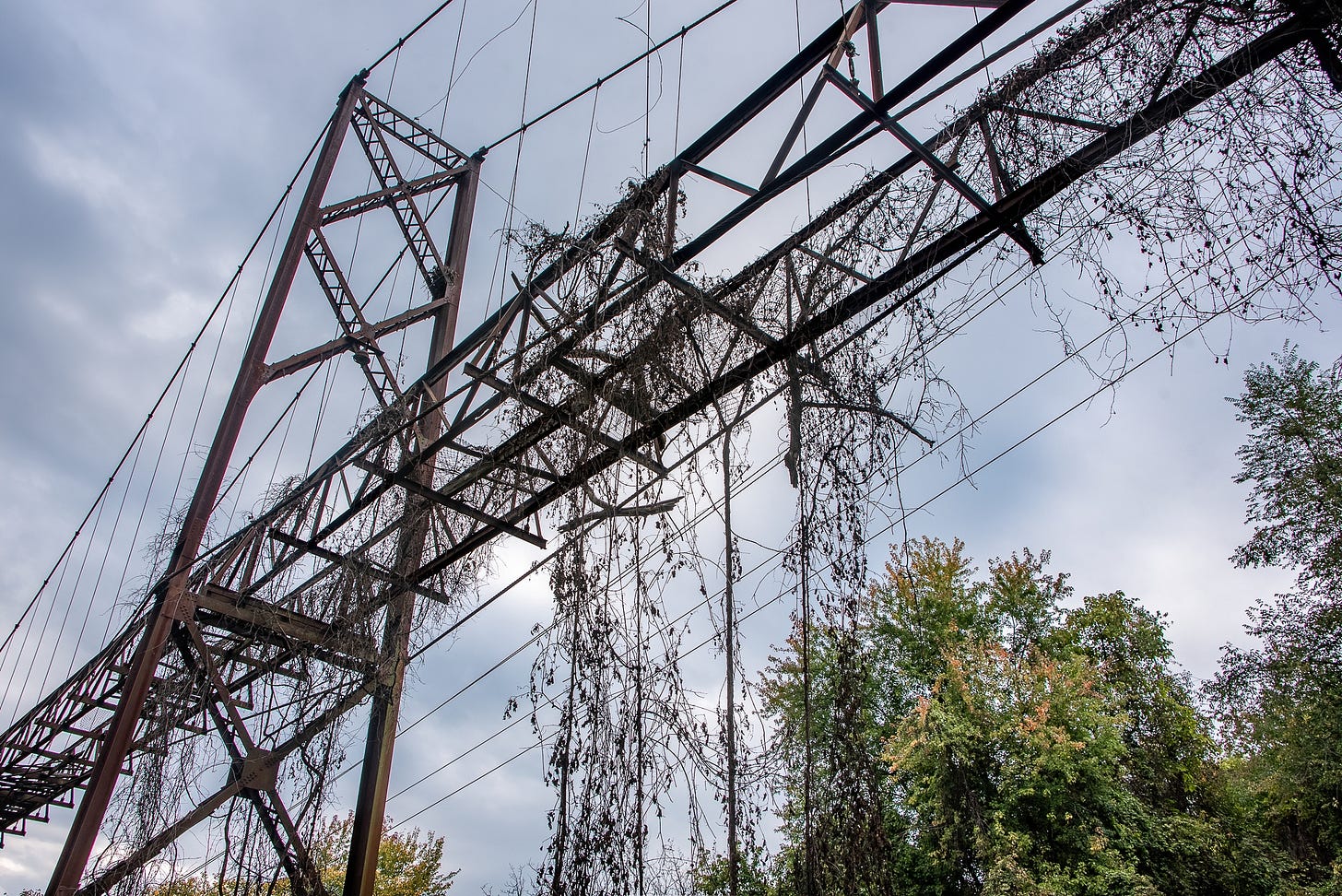


Loved the podcast episode on this, glad to see it expanded and with the great photos.